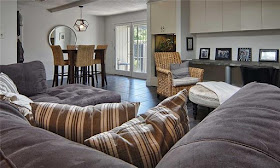Henry Hill (1913-1984) was born in England, but the architect grew up in Berkeley, California, and is best known for the design work he did in the San Francisco area.
He studied architecture at the Berkeley campus of the University of California and then went on to Harvard's Graduate School of Design, working with the famed Walter Gropius. After earning his master's degree in architecture in 1937, his first job was with John Elkin Dinwiddie. He made partner in 1939. During World War II, he was a captain in the U.S. Army Corps of Engineers. When the war ended, he returned to the firm, joined by new parter Eric Mendelsohn, but by 1948 he was working on his own, bringing Jack Kruse into his firm. Kruse became a partner in 1965.
Hill's style has been described as a "fusion of European modernism and a reverence for the rustic landscape of Northern California." That brand of modernism has come to be known as the Second Bay Tradition. Hill's houses are easily recognizable from the outside: boxy, flat-roofed or low-gabled, usually on a hill with a view, walls of windows, a broad overhang or an open, rectangular lattice over windows. Also, gardens are integral to his design. Hill houses have a distinctive palette of natural shades of grays, browns and golds, accented by windows of what he called "deep plum red," or occasionally green. Orange tiles and panels were common.
Inside the houses often have several layers of interlocking split-levels. Stairways are often bordered by slats or screens, and wall coverings are often grass cloth or silvery wallpaper. Open beam ceilings are plywood or planks. Fireplaces are often gilt.
Over the course of his career, Hill designed upwards of 500 homes in the Bay Area, as well as commercial buildings.
From dwell.com, sfgate.com and snipview.com
 |
| socketsite.com |
 |
| socketsite.com |
 |
| snipview.com |
 |
| sfgate.com |



















































